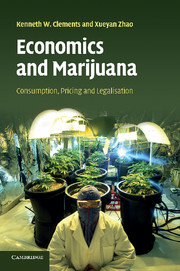Book contents
- Frontmatter
- Contents
- List of figures
- List of tables
- About the authors and contributor
- Acknowledgements
- 1 Introduction
- 2 Microeconometric evidence on marijuana consumption
- 3 The pricing of marijuana
- 4 More on the economic determinants of consumption
- 5 Decriminalising and legalising marijuana
- 6 Are Australians unique?
- 7 Perspectives
- Index
2 - Microeconometric evidence on marijuana consumption
Published online by Cambridge University Press: 19 January 2010
- Frontmatter
- Contents
- List of figures
- List of tables
- About the authors and contributor
- Acknowledgements
- 1 Introduction
- 2 Microeconometric evidence on marijuana consumption
- 3 The pricing of marijuana
- 4 More on the economic determinants of consumption
- 5 Decriminalising and legalising marijuana
- 6 Are Australians unique?
- 7 Perspectives
- Index
Summary
Introduction
Unlike data on the consumption of legal commodities, those on marijuana consumption are scarce at both micro and macro levels for empirical investigation of consumer behaviour. According to an Australian study (Collins and Lapsley, 2002), illicit drug-related illnesses, deaths and crimes cost approximately AU$6.1 billion in 1998– 9 in Australia. As in many developed countries, significant amounts of public funds have been spent by the Australian government on dealing with the consequences of illicit drug abuse and on educational programmes. Much debate has surrounded the use of governmental coercive power in influencing drug consumption through education and legislation.
Crucial to any effective marijuana policy are empirical studies that afford a better understanding of consumer behaviour. For example, who and where are the marijuana users? What proportion of the population is using the drug regularly? What are the socioeconomic and demographic factors that affect an individual's decision to participate in the consumption of marijuana? How does an individual's consumption of marijuana relate to his/her consumption of other legal (such as tobacco and alcohol) and illegal (such as heroin and cocaine) drugs? How do consumers respond to changes in the prices of marijuana and other related drugs? What is the impact on consumption of decriminalisation? And how has Australian consumption of marijuana changed over time? The popularity of marijuana, the size of its underground market, ongoing debate surrounding government policies regarding decriminalisation or legalisation, and the notion of gateway effects of marijuana leading to consumption of harder drugs for the young have all made micro-level research on marijuana consumption worthwhile. Answers to the above questions are invaluable in designing and evaluating marijuana policies and education campaigns within a multiple drug framework.
- Type
- Chapter
- Information
- Economics and MarijuanaConsumption, Pricing and Legalisation, pp. 15 - 66Publisher: Cambridge University PressPrint publication year: 2009

